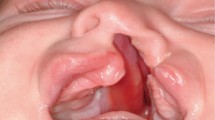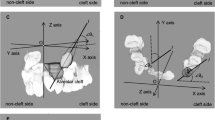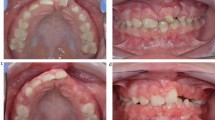Key Points
-
Presents a relatively rare fracture of the maxilla and palate in a sagittal direction.
-
Describes orthodontic treatment of the Le Fort II fracture.
Abstract
An unusual presentation of palatal fracture is described. Reduction and fixation with an orthodontic appliance proved to be an efficient and novel method in the treatment of this fracture.
Similar content being viewed by others
Introduction
Fractures that split the maxilla and palate in a sagittal direction are relatively rare compared to other types of fractures seen in the upper half of the craniofacial complex such as those in the Le Fort series.1 A fracture of the palate in this plane requires significant energy and as a result it is commonly accompanied by other complex facial fractures.2 Sagittal fracture of the palate may be seen in isolation or associated with comminuted Le Fort fractures.1 A relatively large series accumulated in a four-year study comprised 376 cases of midfacial fractures of which only 8% had palatal fractures.3
Classification
Palatal fractures have been described according to the anatomy of fracture line.3 They most commonly divide the palate anteroposteriorly just off the midline, because the bone lateral to vomerine attachment of maxilla is relatively thin. Through the body of the maxilla they run parallel to the midline, but anteriorly they usually exit between the canines, while posteriorly, they may remain parallel or deviate towards the tuberosity.
Case report
A 22-year-old Caucasian male attended an accident and emergency department following an alleged assault in a nightclub. The patient had a Glasgow Coma Score of 15 and there had been no loss of consciousness. At some point in the assault he recalled he had been kicked in the face. On examination, extensive contusions were noted infraorbitally and over the dorsum of the nose which carried a small laceration at the bridge. No abnormalities were noted on the radiographs taken at that time. The patient was advised to contact his local ENT department for follow up. Two weeks later the patient attended the ENT department at Southmead hospital. A diagnosis of septal deviation of the nose was made but with no nasal bone injury. The patient was concerned that a diastema had developed between the central incisors since the assault and he was referred to the Oral and Maxillofacial Surgery and Orthodontic Department.
On examination a 2 mm central diastema was noted together with a small posterior open bite (Fig. 1). The diastema could be eliminated with strong finger pressure. No intraoral mucosal lacerations or bruises were found. On palpation of the right infraorbital margin a small step was noted which was eliminated if the central incisors were approximated with finger pressure.
The orthodontists noted that the patient had previously undergone fixed appliance treatment when 14 years old. The occlusion was essentially class I on a skeletal 1 pattern. Special investigations included intraoral periapicals, an upper standard occlusal radiograph (Fig. 2) and an orthopantogram. From these it was noted that there was blunting of the root apices of upper and lower incisors, a right parasagittal palatal fracture line running parallel to the midline but no obvious alveolar fractures were noted. The palatal fracture was slightly displaced, and was thought to be responsible for the diastema. At this stage it was clear that correction of the diastema would also reduce the Le Fort II fracture. A sectional fixed appliance was used to level and align the teeth prior to space closure with elastic power chain. The central diastema closed in a matter of weeks and the appliance was removed after three months when there was radiographic evidence of bony infilling at the site of fracture. Initial retention comprised full time wear of a vacuum formed splint. The patient was reviewed after three months, when it was noted that the diastema remained closed.
Comment
Palatal fractures are relatively rare3,4 and only a few cases have been reported in the literature. As with other fractures of the facial skeleton, the most usual correction is by open reduction and rigid internal fixation.1,3 Management by closed reduction is quite rare since the majority of palatal fractures are usually associated with severe midfacial fractures.
The diagnosis of this case was unusual since there was no Le Fort I fracture, the right Le Fort II fracture was minimally displaced and the palatal fracture was not associated with any tearing or bruising of the palatal mucosa. The diagnosis of the palatal and Le Fort II fracture was suspected because of the presenting occlusal abnormalities. Orthodontic correction of the two fractures was clearly indicated and although unusual this proved to be an efficient and effective means of correcting a minimally displaced palatal fracture without the need for surgery.
References
Manson P N, Shack R B, Leonard L G et al. Sagittal fractures of the maxilla and palate. Plast Reconstr Surg 1983; 72: 484–489.
Park S, Ock J J . A new classification of palatal fracture and an algorithm to establish a treatment plan. Plast Reconstr Surg 2001; 107: 1669–1676.
Hendrickson M, Clark N, Manson P N et al. Palatal fractures: classification, patterns and treatment with rigid internal fixation. Plast Reconstr Surg 1998; 101: 319–332.
Denny A D, Celik N . A management strategy for palatal fractures: a 12-year review. J Craniofac Surg 1999; 10: 49–57.
Author information
Authors and Affiliations
Corresponding author
Additional information
Refereed paper
Rights and permissions
About this article
Cite this article
Sabherwal, R., Irvine, G. & Sandy, J. Orthodontic management of a Le Fort II and midline palatal fracture. Br Dent J 202, 739–740 (2007). https://doi.org/10.1038/bdj.2007.535
Published:
Issue Date:
DOI: https://doi.org/10.1038/bdj.2007.535





